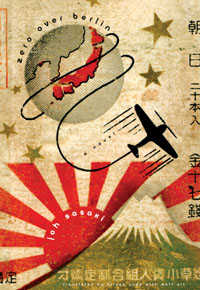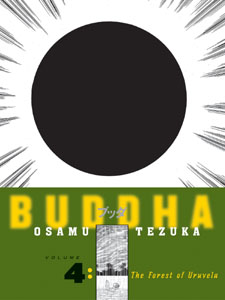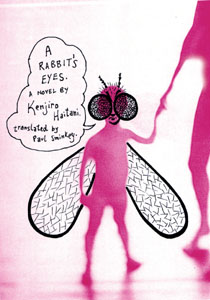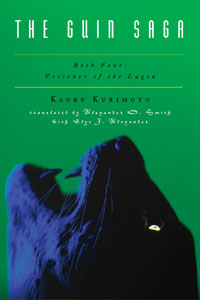Beyond The Classics
Back to Contents of Issue: July 2004
|
|
|
|
by Bruce Rutledge |
|
 While Japanese anime, manga and pop art creep into the North American mainstream, most of the nation's novelists remain virtual unknowns in the West. Beyond Haruki Murakami, Banana Yoshimoto and Kenzaburo Oe is a whole world of the imagination that has been locked away in a box reserved for Japanese readers. Vertical Inc. of New York has decided it's time to unlock it.
Arthur Waley's 1925 English translation of The Tale of Genji had an initial print run of just 2,500 copies, according to Japan scholar and Columbia University professor Donald Keene. Fifteen hundred copies were sent to the UK, and 1,000 to the US. When those sold out, an additional print run of 500 was ordered. There just wasn't much appetite in the West for Japanese literature in those days.
Around the same time, the Japanese could browse through the Japanese translations of the latest novels by Ernest Hemingway, Upton Sinclair and John Dos Passos at their local bookstores. In fact, they could read everything from the dime novels of Bertha M. Clay, a nineteenth century writer of sappy love stories, to the complete works of William Shakespeare.
Even today, Japan's bookstores offer perhaps the most open marketplace for ideas in the world. "I've been told that if one could only read in one's own language, one could read more of the literature of the world in Japanese than in any other language," Keene told an audience at Portland State University in early May. "The most untranslatable works have been translated. James Joyce's Ulysses has been translated into Japanese three times, each time by outstanding writers. There's even a translation of Finnegan's Wake."
Although this translation imbalance has been somewhat corrected in the decades after World War II, the Japan Foundation reports that for every Japanese book translated into a foreign language today, 20 foreign works are translated into Japanese. And yet Japan makes up a significant 10 percent of the world's publishing business.
Why aren't more Japanese books translated into English? This question puzzled former Nihon Keizai Shimbunsha book editor Hiroki Sakai for years. In 1999, he decided to find the answer for himself.
Sakai started Vertical with money from Itochu International and Nikkei BP. "We needed to spend money one or two years before the books came out," he said in a phone interview from New York. "We are planning to increase in size, so we are calling out to potential investors now. Since we don't have a big hit yet, we have to keep putting out books."
Sakai moved from Tokyo to New York in 1999 to see if he could find a way to get more Japanese books into the hands of English readers. At first, he ran a company that translated Japanese works, then tried to sell them to big publishing houses. He quickly began to experience firsthand the obstacles that keep more books from being translated into English.
"It was difficult to get a translator to do a first-rate job on a work that may never be published," he recalls. "There was little incentive. Also, the publishers didn't read Japanese, and at times they would try to 'fix' the translated work. I began to think, this is exhausting work!"
In 2001, Sakai decided that to get more Japanese works published in English, he'd have to do it himself. Once he established Vertical, some key pieces began falling into place for him.
First, editorial director Ionnas Mentzas joined the team. Mentzas grew up in Kobe and was a published translator when he joined Vertical. Without him, Sakai says, Vertical would not exist. "The two of us have discussions to decide what to publish," Sakai says. "We're not concerned with whether a writer is famous or if the book is a bestseller in Japan. Rather, we think about what will sell in the American mass market."
The latest offering from Vertical, due out in July, is Zero Over Berlin, a World War II novel from the perspective of the Axis powers, by Joh Sasaki. "Hitler was steadily losing to the English Spitfires in World War II," Sakai explains. "Japan's Type Zero was a high-quality airplane. The Germans wanted to see one to decide whether to license it out. So they had to get a Type Zero to Berlin, but they couldn't fly over the Soviet Union. The story follows a pilot as he flies through Asia, pinpointing his landings in safe places in India and other countries under British control.
"There are many stories about World War II from the Western side," Sakai adds. "This is an entertaining look at the war from the other side."
Sakai was able to recruit noted book designer Chip Kidd to be Vertical's art director, and the relationship has resulted in dynamic-looking book covers that are very different from the Japanese originals. While getting Kidd to design the books for a small publishing startup was a coup of sorts for Vertical, Sakai stresses that Japan's anime industry deserves the credit. Sakai mentioned to Kidd that Vertical was publishing a book called Buddha in English. Kidd, an anime fan, quickly asked, "Is that Tezuka's Buddha?" A working relationship between Vertical and Kidd was forged soon after that.
Despite the many impressive titles and the glowing reviews (several of the company's translations have received literary awards), Vertical faces a steep climb to success. Kinokuniya's Seattle store, for example, carries the complete Vertical line of books, but "sales have so far been lackluster," Martin Hall, a book purchaser for Kinokuniya, replies in an email. "My guess is that there has not been enough marketing."
Sakai admits that it has been hard going carving out a name for the company in a country notorious for shunning translated work.
"Translations of Japanese into English continue to appear, but very few are now being published by major houses," Keene told his Portland audience. "Knopf, the most distinguished publisher of translated literature, now seems to only be interested in the works of Murakami Haruki.
"The situation of Japanese literature today is, on the whole, rather depressing," the professor added. "Oe Kenzaburo, by virtue of his Nobel Prize ... is preeminent, but his books are read by relatively few people. One gets the feeling that Japanese literature today is marking time, waiting for the emergence of a new and wonderful writer."
Sakai hopes to be the one to introduce that writer to the world. But in the meantime, he has a business to run. To break through to the American reader, Sakai says, "We focus on genres. It is said that Americans don't go for translated books, but if it is in a genre they like--horror, drama, et cetera--they'll give it a try. It also makes the marketing more streamlined."
While Vertical is doing business in the capital of American publishing, New York City, the Japanese genres Sakai talks about have been catching on for several years in independent bookstores across the US. Small booksellers are adding Japanese manga, toys, anime, graphic novels, artwork and books to their regular offerings. You can see similar collections of goods and books in Reading Frenzy in Portland, which sits in the shadow of the giant Powell's City of Books; Super 7 in San Francisco's Japantown, which opened on June 1; Quimby's in Chicago; Confounded Books in Seattle and Spoonbill & Sugartown in Brooklyn.
Reading Frenzy proprietress Chloe Eudaly, who has yet to visit Japan, sums up her customers this way: "Different people come to appreciate Japanese culture in different ways, and they don't necessarily go for anything outside of their particular niche. For instance, my Japanese toy/monster fans might not care about girls tied up in knots or cutesy stationery. I have customers who are creative types that will snap up anything I can get on contemporary Japanese art and design. Still others are big fans of Japanese lit, but don't particularly relate to the visuals."
"By far and away, the most popular Japanese titles are manga," writes Hall of Kinokuniya. "Over the past four years that I've worked here, I would characterize sales of Japanese fiction (non-graphic) as flat but steady, with the exception of new titles, such as Kirino Natsuo's Out, which sold well when it first came out. A spike in sales occurred in the wake of the film The Last Samurai. Yoshikawa Eiji's Musashi and Taiko have always sold well, but that movie gave them an extra boost. Takami Koushun's Battle Royale is the best-selling Japanese title by far."
Film has regularly played a role in raising awareness of Japanese books in the West. Ryonosuke Akutagawa's classic Rashomon was translated into English only after the debut of Akira Kurosawa's film version of the novel in 1950, for example. Sakai hopes to invert that trend by attracting a studio to one of his company's works.
He has reason for optimism. "Major Hollywood studios have inquired about The Guin Saga," he offers.
So far, The Guin Saga's first 93 episodes have sold more than 27 million copies in Japan, Sakai says. You can almost feel his hope through the phone as he speaks. If Hollywood makes one episode into a hit movie--and follows that up with a sequel or two--Americans may be seeing a lot more Japanese titles in their local bookstores after all. @
|
|
Note: The function "email this page" is currently not supported for this page.


 Sakai founded [
Sakai founded [ This is some of what Mentzas and Sakai have come up with so far: The first four installments of Buddha, a series of graphic novels by Osamu Tezuka; Ring and Spiral, by Koji Suzuki; the first four books of The Guin Saga, a still unfinished epic of 100 installments, by Kaoru Kurimoto; Sayonara, Gangsters, a postmodern work featuring a poetry teacher and a gang that kills a series of US presidents, by Genichiro Takahashi; Twinkle Twinkle, the story of a modern marriage unraveled by the dark secrets between the husband and wife, by Kaori Ekuni; and Ashes, a hard-boiled novel by Kenzo Kitakata, who has published more than 100 novels but never had any of them translated into English until now.
This is some of what Mentzas and Sakai have come up with so far: The first four installments of Buddha, a series of graphic novels by Osamu Tezuka; Ring and Spiral, by Koji Suzuki; the first four books of The Guin Saga, a still unfinished epic of 100 installments, by Kaoru Kurimoto; Sayonara, Gangsters, a postmodern work featuring a poetry teacher and a gang that kills a series of US presidents, by Genichiro Takahashi; Twinkle Twinkle, the story of a modern marriage unraveled by the dark secrets between the husband and wife, by Kaori Ekuni; and Ashes, a hard-boiled novel by Kenzo Kitakata, who has published more than 100 novels but never had any of them translated into English until now.
 When asked about this national resistance to translations, Professor Keene replied, "There is an American resistance to translations, but that doesn't mean they don't sell. They don't sell a lot in a short time."
When asked about this national resistance to translations, Professor Keene replied, "There is an American resistance to translations, but that doesn't mean they don't sell. They don't sell a lot in a short time."



